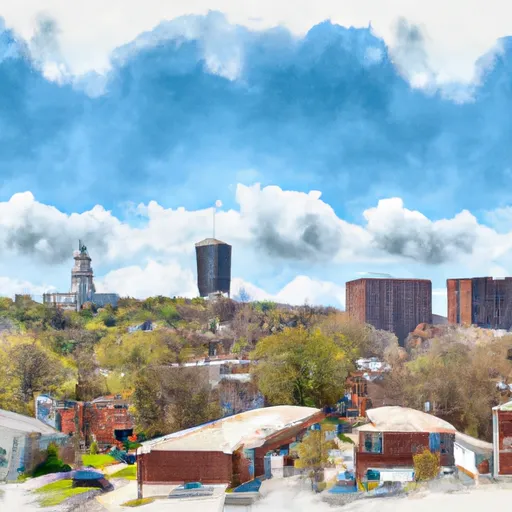-
 Snoflo Premium
Snoflo Premium
Get unlimited access to all our content
With no Ad interruptions! - Start Your Free Trial Login with existing account
Temple-Hills
Eden Index
Climate
8.3
•
Recreation
7.2
•
Community
2.6
•
Safeguard
6.5/10

Temple Hills, Maryland is a vibrant community located in Prince George's County. The town experiences a humid subtropical climate characterized by hot and humid summers, with average temperatures ranging from 75 to 90°F, and mild winters, with average temperatures ranging from 30 to 50°F. Precipitation is evenly distributed throughout the year, with significant rainfall occurring in the summer months.
The region is blessed with an abundance of hydrological constituents, including the Potomac River and several creeks, providing ample opportunities for water-based activities. Fishing enthusiasts can enjoy catching a variety of species, such as bass, catfish, and perch in these water bodies.
Outdoor recreation opportunities in Temple Hills are plentiful. The town features numerous parks and green spaces that offer facilities for picnicking, jogging, and sports like basketball and tennis. The nearby Oxon Hill Farm provides an educational experience with its working farm, allowing visitors to interact with farm animals and learn about agricultural practices.
In summary, Temple Hills, Maryland, boasts a pleasant climate, rich hydrological resources, and a range of outdoor recreational activities, making it an attractive destination for nature lovers and outdoor enthusiasts.
What is the Eden Index?
The Snoflo Eden Index serves as a comprehensive rating system for regions, evaluating their desirability through a holistic assessment of climate health, outdoor recreation opportunities, and natural disaster risk, acknowledging the profound impact of these factors on livability and well-being.
Climate Health Indicator (CHI): 8.3
Temple-Hills receives approximately
1082mm of rain per year,
with humidity levels near 80%
and air temperatures averaging around
14°C.
Temple-Hills has a plant hardyness factor of
7, meaning
plants and agriculture in this region tend to thrive during the non-winter months.
By considering the ideal temperature range, reliable water supplies, clean air, and stable seasonal rain or snowpacks, the Climate Health Indicator (CHI) underscores the significance of a healthy climate as the foundation for quality living.
A healthy climate is paramount for ensuring a high quality of life and livability in a region, fostering both physical well-being and environmental harmony. This can be characterized by ideal temperatures, reliable access to water supplies, clean air, and consistent seasonal rain or snowpacks.
Weather Forecast
Streamflow Conditions
Potomac
Area Rivers
Potomac
Snowpack Depths
Potomac
Reservoir Storage Capacity
Potomac
Groundwater Levels
Recreational Opportunity Index (ROI): 7.2
The Recreational Opportunity Index (ROI) recognizes the value of outdoor recreational options, such as parks, hiking trails, camping sites, and fishing spots, while acknowledging that climate plays a pivotal role in ensuring the comfort and consistency of these experiences.
Access to outdoor recreational opportunities, encompassing activities such as parks, hiking, camping, and fishing, is crucial for overall well-being, and the climate plays a pivotal role in enabling and enhancing these experiences, ensuring that individuals can engage in nature-based activities comfortably and consistently.
Camping Areas
| Campground | Campsites | Reservations | Toilets | Showers | Elevation |
|---|---|---|---|---|---|
| Andrews AFB Military | None | 269 ft | |||
| Fort Belvoir Travel and RV Camp | 52 | 132 ft | |||
| Louise F. Cosca Regional Park | 23 | 223 ft | |||
| Greenbelt Park | 175 | 121 ft | |||
| Cedarville State Forest | 27 | 198 ft |
Nearby Ski Areas
Catastrophe Safeguard Index (CSI):
The Catastrophe Safeguard Index (CSI) recognizes that natural disaster risk, encompassing floods, fires, hurricanes, and tornadoes, can drastically affect safety and the overall appeal of an area.
The level of natural disaster risk in a region significantly affects safety and the overall livability, with climate change amplifying these risks by potentially increasing the frequency and intensity of events like floods, fires, hurricanes, and tornadoes, thereby posing substantial challenges to community resilience and well-being.
Community Resilience Indicator (CRI): 2.6
The Community Resilience Indicator (CRI) recognizes that education, healthcare, and socioeconomics are crucial to the well-being of a region. The CRI acknowledges the profound impact of these elements on residents' overall quality of life. By evaluating educational resources, healthcare accessibility, and economic inclusivity, the index captures the essential aspects that contribute to a thriving community, fostering resident satisfaction, equity, and social cohesion.

